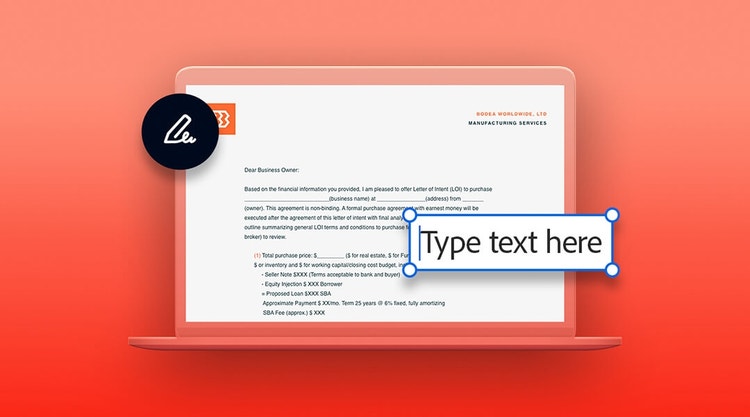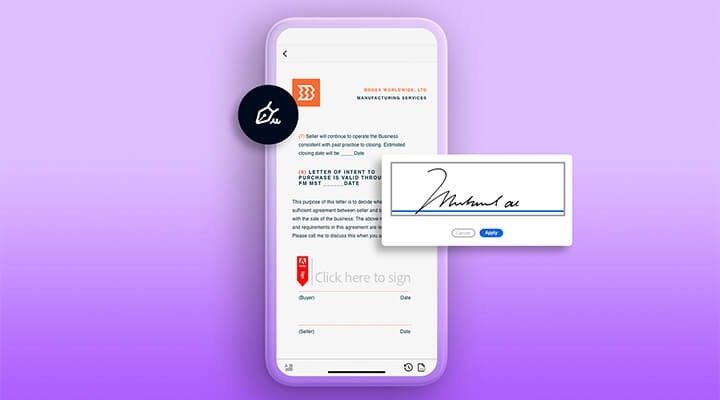Adobe Acrobat Sign
How to write a letter of intent to purchase.
Use this nonbinding business letter to establish the details of a future transaction, such as a real estate purchase, before a binding agreement is crafted.

What is a letter of intent to purchase?
This type of letter of intent (LOI) can be used as a starting point for negotiating the basic terms of a purchase to ensure a fair deal for both parties. Details in the letter can include information about both parties, the purchase timeline, purchase price, payment method, and more. While a letter of intent to purchase is not legally binding, it can lay the groundwork for an official purchase agreement.
When and why should you use one?
A letter of intent to purchase can be helpful for any type of complicated transaction that requires careful negotiation. It is similar to a memorandum of understanding in that it is not a definitive agreement but instead is a stepping stone toward one.
Benefits of LOIs for sellers.
As a seller, this type of letter can be an important step in your due diligence process; if a dispute arises down the line, it helps prove you were negotiating in good faith.
Benefits of LOIs for buyers.
While it won’t necessarily give the buyer exclusivity or guarantee the purchase for them, signing a letter of intent confirms their interest in the purchase and serves as a record of where they stand on the terms.
Other benefits:
- Helps the negotiation process progress for both parties
- Saves time by exposing potential roadblocks to the transaction early
- Keeps transactions transparent and predictable for both parties
- Can help a potential buyer secure a loan for the upcoming purchase

What to include in letters of intent to purchase.
Be as clear as possible with what you outline in your letter, and seek legal advice to make sure the terms of your transaction are fair. This enables smooth negotiations and will make it easier to create a final purchase agreement that satisfies both parties. Before drafting a letter of intent, each party may want to submit a term sheet listing the items they wish to include in the letter.
Your letter may contain the following elements:
- Name and contact information of the buyer
- Name and contact information of the seller
- Detailed description of the items or property being sold
- Any relevant disclaimers or liabilities
- The total purchase price
- Method of payment and other payment terms, including dates
- A standstill order during which the seller won’t negotiate with other buyers
- Covenants and other contingent agreements
- Warranties and indemnifications and their expiration dates
Real estate letters of intent for commercial property.
Because of their complexity, commercial real estate transactions often begin with a buyer making an offer with a letter of intent to purchase. These can include additional clauses relating to real estate terms, such as where responsibility will fall for paying off outstanding loans and a list of any required repairs or conditions the seller must meet prior to the closing date.

Make, manage, and digitally sign letters of intent.
Whether you’re a buyer or a seller, going digital with your letters of intent can help you streamline the negotiation process. If your job involves numerous transactions, create a letter of intent template to use again and again. Plus, send or sign letters quickly without printers or visits to the post office.
Do more with Adobe Document Cloud.
When you’re ready to work from your LOI template or track the letters you have already sent, Document Cloud makes it easy.
Edit or delete a template that you’ve created.
Discover how to manage templates. Edit and rename them, share them with other Document Cloud users, and remove old versions.
Manage and track your documents that are out for signature.
The Manage page lets you see if your documents have been signed, are still waiting for signature, or have been declined by the signer.

Acrobat Pro takes the stress out of getting signatures for important business transactions and managing your documents. Make every sale go smoothly.
